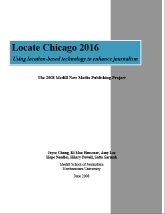 I previously wrote about the “locative storytelling” project of a team of Northwestern University graduate students to study the intersection of journalism and emerging location-based technologies.
I previously wrote about the “locative storytelling” project of a team of Northwestern University graduate students to study the intersection of journalism and emerging location-based technologies.
The team has concluded its project and presented its findings, which they summed up here in 12 points and have made available as a downloadable PDF.
I still don’t totally grok “LoJo” as Locative Journalism is nicknamed, but a couple of highlights resonated with me:
… locative stories delivered to portable devices has taught us that this kind of storytelling, at its best, can be extremely compelling… We live in an era of user-generated content and participation. Young adults, in particular, are used to sites that allow comments, rating or reviews, and sharing. Sites such as Yelp and YouTube have been distinguished and made popular by these qualities. Social networking sites such as Facebook have applications that allow for easier sharing of news stories and other content. … We are accustomed to using linear interfaces, such as alphabetized directories and timelines, to organize and access information. But our experiences in the real, physical and non-digitized world are usually not linear. They’re spatial, dynamic and intuitive.
